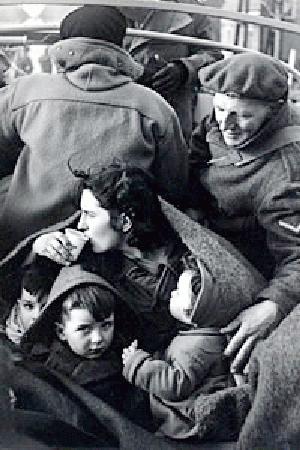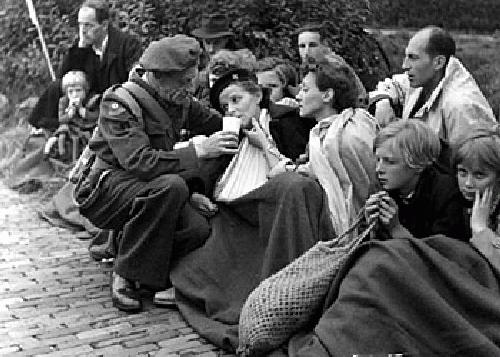
Figure 1.--Children here are being evacuated from the island of Tholen which was almost completely flooded.


Figure 1.--Children here are being evacuated from the island of Tholen which was almost completely flooded. |
A Dutch reader tells us, "Today is special to most Dutchmen: On February 1, 1953, spring tide and storm winds sweeping the North Sea combined to produce one of the biggest disasters ever in Holland and Flanders. The resulting floods were the largest since the infamous
All Saints’ Flood of 1570.
A Dutch reader tells us, "Today is special to most Dutchmen: On February 1, 1953, spring tide and storm winds sweeping the North Sea combined to produce one of the biggest disasters ever in Holland and Flanders. The resulting floods were the largest since the infamous
All Saints’ Flood of 1570 and hit the Scheldt, Maas and Rhine river delta in the southwestern part of the Netherlands and adjoining areas in the Belgian
provinces of East-Flanders and Antwerp. In the Netherlands 1835 people died, some twenty thousand cattle drowned, 4,500 houses were completely destroyed, 200,000 acres of farmland were flooded. For days on end, people sat in treetops and attics, often without
food and sparsely clothed, while the storm raged and the swirling watrers carried drowned bodies, livestock and furniture out to the North Sea. More than 40,000 houses became uninhabitable and 72,000 people had to be evacuated."
Help came immediately from neighbouring countries and from overseas, even from poorer countries like Colombia and India. Substantial contributions came from the U.S. and Canada, the second time in hardly a decade. The Americans and Canadians helped the Dutch people at the end of World War II. The NAZIs had cut off ffod supplies to civilians. Many Dutch civiliabs were near starvation when the Allies arrived in the Spring of 1945. All of these contributions are today being remembered with affection and gratitude. Reconstruction began almost immediately after the floods had receeded and led to the ‘Deltaplan’, a series of flood barriers, dikes and dams that were to reshape the aspect of the area. These days, 50 years later, people who were children in 1953 recall those frightful days and remember parents and siblings who were taken from them. Their stories are broadcast and published in papers and on the web. I just heard a man from Zeeland who mentioned a supply of American jeans that made him and his brothers the first in his region to wear denim. Another man remembers his wife who drowned with all of their seven children aged 1 to 10 years of age and his brother who perished with his wife and four children.

Figure 2.--Here homeless families are being looked after by Red Cross volunteers. |
February 1 is neither a holiday nor a national memorial day in the Netherlands, but it is a day of remembrance for many Dutch people. Every year on February 1, the floods will be mentioned on TV and the papers will publish interwiews with survivors and eyewitnesses. And of course, yesterday being the 50th anniversary, even more attention weas given than
the year before.
The Netherlands was not the only country impacted by the 1953 Northsea Floods. Of course the Netherlands was the country most seriosly impacted because part of the Netherlands are below sea level. The 1953 floods also did severe damage along the east coast of England. A Dutch reader mentions, "HBC's paragraph on the floods in England is very interesting. I'd never realised this (though I'm not at all surprised). Nor did I see any reports in the
Dutch press. It goes to show to what extent a nation's collective memory can be restrictive.
In the wake of yesterday's commemoration I read about floods in bygone centuries and they seem to have been frightfully devastating and frequent. Dozens of them are on record since the Middle Ages, with casualties far more numerous than those of 1953. Yet only three have entered our 'collective memory': St.Elizabeth's Floods of 1421, All Saints' Floods of
1570 and "The" Floods of 1953.
Navigate the Boys' Historical Clothing Web Site:
[Return to the Main postwar chronology page]
[Introduction]
[Activities]
[Biographies]
[Chronology]
[Clothing styles]
[Countries]
[Bibliographies]
[Contributions]
[FAQs]
[Glossaries]
[Satellite sites]
[Tools]
[Boys' Clothing Home]
Navigate the Boys' Historical Clothing Dutch pages:
[Maiken Island]
[Dutch choirs]
[Dutch scouts]
[Dutch school uniform]
[Dutch boys bangs]
[Dutch post cards]
[Dutch catalogs]
Navigate the Boys' Historical Clothing national pages:
[Return to the Main Dutch 1950s page]
[Return to the Main Dutch page]
[Australia]
[Belgium]
[England]
[France]
[Germany]
[Ireland]
[Italy]
[Japan]
[Korea]
[Mexico]
[Scotland]
[United States]
